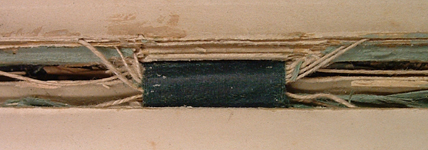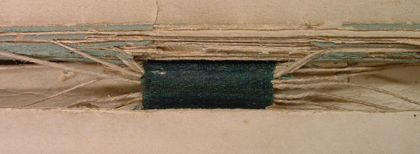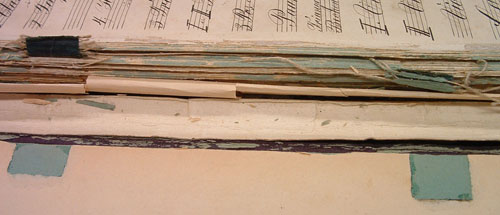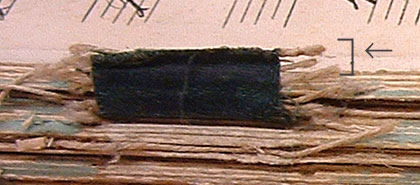
![Main heading: The Music of Gustav Mahler: A Catalogue of Manuscript and Printed Sources [rule] Paul Banks](../../images/General%20Heading3.jpg)
Symphony No. 1: the original movement order
The fact that the earliest surviving manuscript of the First Symphony (ACF1) is incomplete (containing only the first movement, scherzo and finale) is tantalizing and frustrating, just as the autograph numbering and re-numbering of the Scherzo – he first wrote ‘2’ and then changed the figure to ‘3’ – is puzzling. It may well be that Stephen McClatchie's opinion (SMFS), that the latter was merely an error on Mahler's part, is correct, but it leaves the more fundamental questions about why Mahler was making an annotation at all, why there was a possibility of confusion in his mind and indeed how many movements there were in the Symphony before he made the annotation, unanswered. Fortunately the current physical structure of the document provides some clues, which, while necessarily only indicative, provide evidence that underpins the conjectures that follow.
The manuscript is currently bound in two volumes in boards covered in black cloth with a faded black spine; the mainly stacked bifolios are glued into gatherings and stitched onto tapes (two per volume) originally attached to the boards (for details of gatherings and binding patterns, see the description of the manuscript structure). The sheets were trimmed during the binding process, with some loss of page numbers and marginal notes. The first volume now contains the first movement and scherzo, so, bearing in mind the movement order at the first performance in Budapest on 20 November 1889, with Blumine placed second in the sequence, the questions that come to mind are: at the time of binding did this volume contain one or more of the now-absent movements (and more especially Blumine), and if so, where was it (were they) situated? Sadly the pagination of the volume (which has separate sequences for each of the movements) offers no clue. However, the binding of the volume is very loose, making examination of the tapes and threads used in the binding process relatively straightforward, and as there is no evidence of any remnants of threads that might have supported sheets that have have been subsequently removed (see Figs 1, 2 below), it seems unlikely that this volume ever contained either of the missing movements.

Fig. 1
Symphony No. 1, ACF1, volume 1, upper tape and threads
© 2007 University of Western Ontario

Fig. 2
Symphony No. 1, ACF1, volume 1, lower tape and threads
© 2007 University of Western Ontario
The second volume is in a rather more distressed condition, which fortunately facilitates examination. Here the tapes have become detached from the front covers, and it is easy to observe that here the tapes still have attached to them the remnants of three severed threads that must have originally supported sheets that were subsequently removed (see Figs 3, 4).

Fig. 3
Symphony No. 1, ACF1, volume 2, tapes and threads
© 2007 University of Western Ontario

Fig. 4
Symphony No. 1, ACF1, volume 2, upper tape and severed threads (bracketed)
© 2007 University of Western Ontario
How many movements, then, have been removed? By examining the structure of this manuscript it is possible to arrive at an informed estimate of the number of bifolios that could have been present. As can been seen from the description of the source, the binder seems normally to have glued three (sometimes four) bifolios together at the fold edge and stitched through the fold of the first to secure the glued gathering to the tape. So between nine and twelve bifolios were probably present at the start of the volume when it was bound. Turning to the next two manuscript sources for the work, it is apparent that the two movements missing from ACF1 occupied in total 10 (AF2) and 9 (ACF2) bifolios respectively (with the funeral march in both cases actually requiring only 5½ bifolios, the remaining pages in the two manuscripts remaining blank). This is strongly suggests that both movements were originally bound at the start of the second volume, though in what order cannot now be determined on the basis of the binding evidence. Nevertheless it is striking that at the first three performances the work was described as being in two parts, with the slow movement and finale forming the second part. This division, which reinforces the fundamental contrast between the relatively uncomplicated and optimistic emotional world of the first three movements and the complex and troubled music of the last two movements seems central to the narrative of the Symphony. So unless Mahler fundamentally rethought the contours of the work after ACF1 was bound – not entirely impossible, as he rethought the Sixth Symphony at an even later stage in the work's evolution – the balance of probabilities is that when the manuscript was bound Blumine was placed third in the sequence; the renumbering of the Scherzo was to reverse the order of the second and third movements. This supposition gains support from a detail in the programme for the work recorded by Nathalie Bauer Lechner in 1900 following conversations with the composer (NBL2, 173); there, after discussing the scherzo she notes
|
Hieran schloß sich ursprünglich ein sentimental-schwärmerischer Satz, die Liebesepisode – von Mahler scherzhaft auch die „Jugend-Eselei“ seines Helden genannt –, den er dann entfernte. |
Following this, there was originally a sentimentally indulgent movement, the love episode - which Mahler jokingly called the ‘youthful folly’ of his hero. Later, he removed it. |
Far from being an error or misunderstanding (which it might otherwise appear) it now seems that Mahler may have been correctly reporting the original movement order of the Symphony.

![]() https://orcid.org/0000-0002-2258-0267
©
2007-21 Paul Banks | This page was lasted edited on
07 January 2021
https://orcid.org/0000-0002-2258-0267
©
2007-21 Paul Banks | This page was lasted edited on
07 January 2021